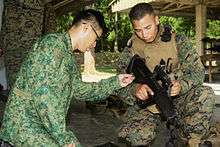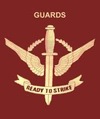Singapore Guards
| Singapore Guards Formation | |
|---|---|
|
Singapore Guards Official Emblem | |
| Active | January 1975 - Present |
| Country | Singapore |
| Branch | Singapore Army |
| Type | Elite Infantry |
| Size | Three battalions (2 Conscripts, 1 Regular) |
| Part of | HQ Guards |
| Garrison/HQ |
Bedok Camp II Complex (1 Guards and 3 Guards) Dieppe Barracks (HQ Guards) Nee Soon Camp (1 ADF) |
| Nickname(s) | The Elite Guards, "Singapore Marines" |
| Motto(s) | Ready to Strike |
| March | The Guards March |
| Commanders | |
| Chief Guards Officer | COL Mark Tan |
| Notable commanders | Melvyn Ong |
| Insignia | |
| Identification symbol | Guards Tab, Khaki Beret with Cap Badge |
The Guards are an elite infantry formation in the Singapore Armed Forces specialising in rapid deployment, heliborne and amphibious operations, maneuver warfare and urban combat. Highly mobile, they are the expeditionary spearhead of the Singapore Army. The formation traces its roots back to the 7th Singapore Infantry Brigade and has been actively involved in several National and Army Day events since the establishment of the modern Guards unit.
History
The formation was formed on 1 January 1975 as the 7th Singapore Infantry Brigade (SIB), with a total personnel strength of four officers and five men.[1][2] The Brigade took command of the Infantry Training Depot (ITD) on 1 January 1976 and the 7th and 8th Battalions of the Singapore Infantry Regiment (SIR) on 9 February 1976. On 1 July 1976, 7 SIB was declared operational.[1] In view of its operational role, the ITD was removed from the Brigade and the Singapore Armed Forces Guards Unit (SAFGU) was added to the 2 remaining battalions.[1][2]
On 1 July 1977, SAFGU was renamed as 1st Battalion, Singapore Guards. A year later on 1 April 1978, 8 SIR became 2nd Battalion, Singapore Guards.[1] 7 SIB was accorded their designation as elite troopers on 1 April 1978. Following that designation, 7 SIR was moved to the 3rd Singapore Infantry Brigade in 1978, leaving 7 SIB with the following sub-units:
- 1st Guards Battalion
- 2nd Guards Battalion
- 1st Commando Battalion
- 10th Commando Battalion (Disbanded)
- School of Commando Training
This arrangement lasted until 1980, when 7 SIB was re-organized into a formation consisting of Guardsmen only. The Commando units were moved elsewhere, and 7 SIR returned to the fold. It was renamed 3rd Battalion, Singapore Guards.[1]
On 17 December 1991, the 7th Brigade Training School (7 BTS) came under the command of the 7 SIB. However, from Sept 1996, all Basic Military Training (BMT) were taken over by Basic Military Training Centre (BMTC), and the 7 BTS was closed down. 11 October 1994 marked the formalisation of Guards as the Guards Formation.[2]
On 6 April 1979, a parade was held to present berets with a new cap badge backing to 7 SIB. Then-Chief of General Staff (CGS), MG (NS) Winston Choo, explained that the backing was a designation of the Guardsmen's new status as elite troopers.[2] The three battalions received their first Colours 11 June 1983. All Guardsmen wear a "Guards" tab on their left sleeve. The tab was presented to the Guardsmen on 23 June 1989 in recognition of their elite designation. On 9 June 1994, the distinctive khaki beret was presented to the formation. Whereas previously Guardsmen wore green berets, all Guardsmen since have worn khaki.[2]
Role

Guardsmen are tasked to fight in challenging terrain for key objectives, notably in urban locations (FIBUA (Fighting in Built Up Areas))[3] and fortified terrain (FOFO (Fighting On Fortified Objectives)).[4] Also adept at amphibious warfare, Guards units may be tasked to assail and seize airfields, beach heads, depots as well as enemy strongholds, acting as the army's spearhead.
The Guards' spectrum of operations has been extended to include non-war related operations (OOTW - Operations Other Than War) such as HADR (Humanitarian Assistance and Disaster Relief) operations as well as PSOs (peace support operations). The formation's rapid deployability meant they could speedily respond to humanitarian disasters in the region, as was apparent during the Asian tsunami disaster of 2004.
The Guards' remit also extends to counter-terrorism. In 2008, they were deployed in the search for escaped terrorist Mas Selamat.
Training
Guardsmen are infantry proficient in heliborne operations.[5] In addition to establishing landing sites in forward areas, Guardsmen also act as pilot guides in landing zones.
Training is rigorous. Before qualifying as full-fledged Guardsmen, trainee officers and specialists undergo a gruelling Guards Conversion Course (GCC). Enlisted men complete Guards Advanced Infantry Training (GAIT) to earn their mark as Guardsmen.[6] Completion of the conversion course and advance infantry training distinguishes Guardsmen from regular infantry. In Dec 2011, the Ministry of Defence released a 7-part web series on the Guards Conversion Course, titled Making The Cut: Guards Conversion Course.
The course requires prospective Guardsmen to undergo a timed 10 km fast march, a 2 km coastal swim and an advanced obstacle course known as the Guards Assault Course (GAC). The GAC is a team course that requires trainees to swim 50 meters, climb a high tower, rappel down, and complete a 5 km run on a standard obstacle course while carrying a hors de combat teammate on a stretcher for the last 1.5 kilometres. The course is done in full battle order (FBO) and sandbags (to meet the weight requirement). Guardsmen are also required to maintain a strict physical fitness regime.
Guardsmen are trained for heliborne insertions into combat zones. They can do this either by rapid disembarkation while the helicopter is landing, or by rappelling from a hovering helicopter, or fast-roping straight onto rooftops.[5] As landing zones may be hostile, Guardsmen train in various forms of combat rappelling.[7] This may involve rappelling head-first. They also train for exigencies. If, due to an injury they are unable to brace themselves against a cliff face, they may be required to rappel unconventionally, with their backs facing the cliff, or with a stretcher.[7] Other methods include "running" down a cliff face, also known as the "Australian rappel".[8]
Guards are also specialised in seaborne assault such as coastal hook, which is an offensive manoeuvre initiated by army forces and executed by forces embarked in surface water craft using the coastal sea or river as an axis of movement, to outflank the enemy to accomplish the assigned tactical mission.
Equipment


Weapons
The Guards utilise all small arms known to be in use with the Singaporean army, such as the SAR-21 assault rifle family, the Ultimax 100 Mark 3 LMG,[9] FN MAG,[9] M203,[9] and the Matador anti-tank rocket launcher.
Vehicles
Apart from the helicopters, the Guards also utilise the Light Strike Vehicle (LSV), a lightweight vehicle that is extremely mobile and agile procured by the Army in 1998 to replace the jeeps which formerly carried their 106 mm recoilless guns.[10] Manufactured in Australia and later in Singapore the LSV is based on an American design, with the vehicle able to traverse difficult terrain, and provide greater mobility and added firepower to the Guardsmen and Infantry soldiers.[10] Weighing 1,500 kg, the LSV can be rapidly deployed by slinging it underneath a helicopter and inserting it into enemy territory.
In 2008, the Guards formation began to utilise the PLUV (Protected Light Utility Vehicle) which is an armoured version of the Ford Everest, the Ford Everest is also a replacement vehicle for the ageing Land Rovers.
The LSV, which can move at a maximum speed of 110 km/h,[11] significantly enhances the mobility of soldiers. The soldiers can now bring heavier and better firepower systems into operations.
Symbols of the Guards
Ready To Strike - Motto of Guards, to be ever prepared to strike against enemy forces[12]
The Wings - Represent the guards heliborne capabilities
Bayonet & Laurel - Symbols of guards superior skills as infantry soldiers[12]
Gold Color Foreground - Loyalty to the nation, devotion to duty and dedication to the task set before us[12]
Maroon Backdrop - Brotherhood and esprit de corps within the formation[12]
Khaki Beret - Instituted on 9 June 1994 as a mark of Distinction as Guardsmen Vocationalists.
Beret Backing - Presented on 6 August 1979 as a symbol of the Guards' status as Elite infantry Soldiers. It is worn by everyone who is currently serving within the formation.
Guards Tab - On 23 June 1989, BG(NS) Boey Tak Hup, presented the Guards Tab to 7SIB. Worn on the left sleeve to identify the soldier with skill sets unique to Guardsmen soldiers.
Stable Belt - Presented on 31 July 1980 to the men of 7SIB by LG(Ret) Winston Choo (then MG and CGS). It used to be worn with the Temasek Green uniforms but was respectively withdrawn from service when the new camouflage uniforms were introduced.
Guards Creed
The Guard's Creed details the values and motto of the Guards Formation "Ready To Strike" It also showcases the rapid deployment nature of the Guards formation as well as the Elite Status conferred upon them.
| “ |
WE are GUARDSMAN WARRIORS. Land warriors from Air and Sea, We are ELITE warriors, |
” |
References
- 1 2 3 4 5 Archived 13 December 2007 at the Wayback Machine.
- 1 2 3 4 5 "The Singapore Army - Guards - History". Totaldefence.sg. Retrieved 20 August 2014.
- ↑ Archived 23 December 2007 at the Wayback Machine.
- ↑ Archived 7 February 2016 at the Wayback Machine.
- 1 2 "The Singapore Army - Guards". Mindef.gov.sg. Retrieved 20 August 2014.
- ↑ http://www.mindef.gov.sg/imindef/mindef_websites/atozlistings/army/army_news/Download_Our_Issues/Issues_2011/_jcr_content/imindefPars/download_1/file.res/Guards_Supplement.pdf
- 1 2 Archived 29 December 2007 at the Wayback Machine.
- ↑ http://www.mindef.gov.sg/imindef/about_us/history/birth_of_saf/v08n07_history.html
- 1 2 3 Archived 29 January 2008 at the Wayback Machine.
- 1 2 Archived 5 January 2009 at the Wayback Machine.
- ↑ "The Singapore Army - Guards - Equipment". Mindef.gov.sg. Retrieved 20 August 2014.
- 1 2 3 4 "The Singapore Army - Guards - Motto/Insignia". Mindef.gov.sg. Retrieved 20 August 2014.
- ↑ Archived 28 December 2007 at the Wayback Machine.
External links
- Official website
- Unofficial Site
- Guards History Page
- cyberpioneer Feature: Making of a Guardsman
- cyberpioneerTV series - "Making the Cut - Guards Conversion Course"
- mindef.gov.sg
